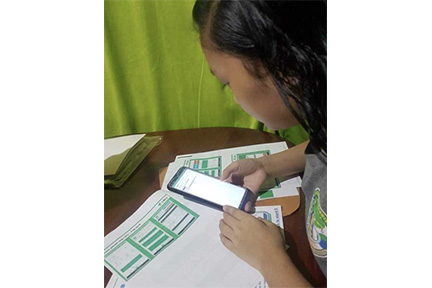What is a Ministry of Economy, Trade and Industry’s “Future Classrooms” demonstration project and overseas demonstration project?
In this age of competition in skills development aimed at producing creative, problem-solving human resources (changemakers), “Learning Innovation” using innovative skills development techniques (EdTech) is being rolled out globally. Using EdTech, the Ministry of Economy, Trade and Industry (METI) is developing and demonstrating a new learning program that combines efficient acquisition of knowledge with cultivation of the ability to identify creative challenges and solutions, with a focus on the three pillars of individually-optimized learning, integration of liberal arts and science (STEAM) and solutions to societal challenges, in order to achieve Future Classrooms designed for proactive learning.
In 2020, METI commissioned Japan External Trade Organization (JETRO) to carry out a Future Classrooms demonstration project abroad with the aim of establishing and identifying the challenges of an effective global expansion model for Japanese EdTech firms.
”Future Classrooms” Demonstration Project
(https://www.learning-innovation.go.jp/)
Digital educational tools platform Libry Co., Ltd., which was selected for this project in 2020, has shared their efforts and achievements in the Philippines and tips for the global roll-out using digital educational tools
***
Libry is a digital educational tools platform with efficient and effective learning functions based on learning components and learning history, such as “Search Problems” and “Recommend Problems,” that has digitalized existing textbooks and workbooks. Libry contributes to work-style reforms for teachers by providing management tools for teachers to check students’ learning history and distribute, collect and tally homework assignments.
Libry’s origins lie in an awareness of the educational disparities linked to where children are born and brought up, hence the company’s corporate vision: “Creating a society where every individual can realize his or her full potential.” Libry’s services are currently available only in Japan, but it aims to expand abroad in future.
This demonstration project was conducted in the Philippines in collaboration with Shinkoshuppansha Keirinkan Co., Ltd., a textbook publishing company with a long history of support for education in Japan, and e-Education, a specially certified NPO closely involved in educational support for developing countries. (https://prtimes.jp/main/html/rd/p/000000015.000054682.html)
Education in the Philippines faces the following challenges.
①Lack of paper-based learning materials in schools
In many schools, especially public high schools, not enough paper textbooks are available to give each student a textbook.
②Overworked teachers
Due to the huge number of students, many teachers are in charge of multiple grades and work a double-shift system. Every teacher has an enormous workload.
③Low academic ability of students especially in science and mathematics
The Philippines ranked 77th*¹ out of 78 countries and regions in the field of mathematical literacy in PISA 2018, the OECD’s Programme for International Student Assessment in 2018.
In the demonstration project, Libry provided learning materials produced by Keirinkan in line with the Philippine curriculum with the aim of improving the quality and efficiency of students’ self-learning and solving the above problems.
Due to the impact of Covid-19, nationwide restrictions in the Philippines barred everyone under the age of 21 from going out and children were unable to attend school, necessitating changes to the initial activity plan. However, for one month from mid-October, Libry was used by students at the pilot junior high school for home study. A mathematics test was held at the end of the demonstration period.

From the results of the test, the students who used Libry in their home studies scored 2.5 times higher marks than the students who didn’t. Additionally, a questionnaire given to the students who used Libry elicited a response from approximately 75% of the students that they “could learn just using Libry instead of paper learning materials.” Today, Libry is already well received by Japanese students, but this project gave us a lot of confidence to know that not only Japanese students but also students in other countries found “Libry’s UI*² easy to use.
However, two issues regarding use of digital educational tools were identified in the demonstration project. One concerned the communication environment in students’ homes. In the questionnaire that was given to the students, 90% responded that there was no Wi-Fi in their home and they used a mobile line instead. It was inferred from this that materials that focused more on text data and that could be partially downloaded to a device were more acceptable than large volume videos or materials containing many images. It was recognized that future service development in Japan too will need to take account of the diverse communication environments in students’ homes.
The second issue concerned the shortage of IT-literate teachers. In the demonstration project, it was intended that teachers would distribute homework to students digitally using Libry, but due to IT literacy and psychological hurdles, distribution was performed mainly by Libry staff. At present, pamphlets and videos containing instructions on how to use Libry are being prepared to facilitate its smooth introduction in Japanese schools, and if there is sufficient demand, training courses for teachers will also be provided. Going forward, it was felt that localization of such tools and teacher training courses will be crucial for expanding Libry abroad.
*1: From “Key Features of OECD Programme for International Student Assessment 2018 (PISA 2018)” (Source: Ministry of Education, Culture, Sports, Science and Technology (MEXT)/National Institute for Educational Policy Research)
*2: UI = User Interface. The user interface is the point of contact between a system or service and the user. User interface is a general term for the display screen and operating procedure, etc. for exchanging information.







